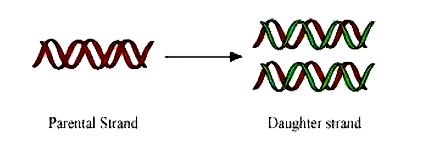Which property of DNA double helix led Watson and Crick to hypothesise semiconservative mode of DNA replication? Explain.
Video Solution
Text Solution
Watson and Crick observed that the two strands of DNA are anti-parallel and complementary to each other with respect to their base sequences. This type of arrangement in DNA molecule led to the hypothesis that DNA replication is semiconservative. It means that the double stranded DNA molecule separates and then, each of the separated strand acts as a template for the synthesis of a new complementary strand. As a result, each DNA molecule would have one parental strand and a newly synthesized daughter strand.
Since only one parental strand is conserved in each daughter molecule, it is known as semi-conservative mode of replication.

|
Updated on:21/07/2023
Topper's Solved these Questions
Similar Questions
Knowledge Check
- Question 1 - Select One
In a DNA double helix :
Athe single strands are not helicalBphosphodiester bonds are oriented towards the interior of the helixCadenine on one strand is hydrogen bonded to thymine on the opposite strand.Dhydrogen bonds form between a purine and pyrimidine base on the same strand. - Question 2 - Select One
DNA is double helix and :
Acomplementary and antiparallelBcomplementary and parallelCwithout supercoilsDalways circular - Question 3 - Select One
Who was/were suggests the semiconservative nature of DNA replication?
AKhoranaBWatsonCCrickDMeselson and Stahl

